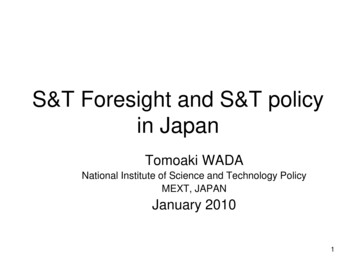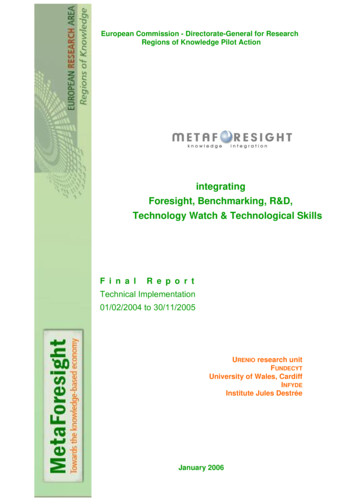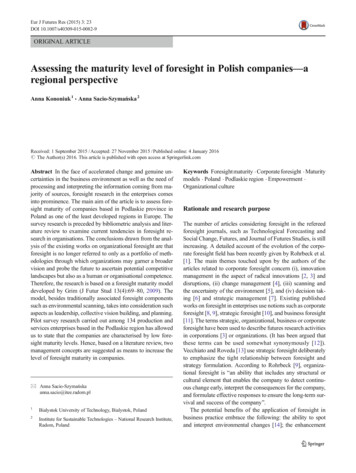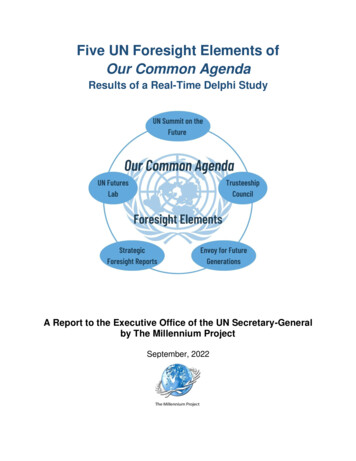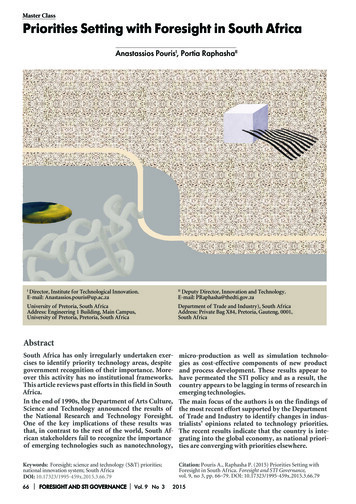
Transcription
Master ClassPriorities Setting with Foresight in South AfricaAnastassios PourisI, Portia RaphashaIIIDirector, Institute for Technological Innovation.E-mail: Anastassios.pouris@up.ac.zaIIDeputy Director, Innovation and Technology.E-mail: PRaphasha@thedti.gov.zaUniversity of Pretoria, South AfricaAddress: Engineering 1 Building, Main Campus,University of Pretoria, Pretoria, South AfricaDepartment of Trade and Industry), South AfricaAddress: Private Bag X84, Pretoria, Gauteng, 0001,South AfricaAbstractSouth Africa has only irregularly undertaken exercises to identify priority technology areas, despitegovernment recognition of their importance. Moreover this activity has no institutional frameworks.This article reviews past efforts in this field in SouthAfrica.In the end of 1990s, the Department of Arts Culture,Science and Technology announced the results ofthe National Research and Technology Foresight.One of the key implications of these results wasthat, in contrast to the rest of the world, South African stakeholders fail to recognize the importanceof emerging technologies such as nanotechnology,micro-production as well as simulation technologies as cost-effective components of new productand process development. These results appear tohave permeated the STI policy and as a result, thecountry appears to be lagging in terms of research inemerging technologies.The main focus of the authors is on the findings ofthe most recent effort supported by the Departmentof Trade and Industry to identify changes in industrialists’ opinions related to technology priorities.The recent results indicate that the country is integrating into the global economy, as national priorities are converging with priorities elsewhere.Keywords: Foresight; science and technology (S&T) priorities;national innovation system; South AfricaDOI: 10.17323/1995-459x.2015.3.66.79Citation: Pouris A., Raphasha P. (2015) Priorities Setting withForesight in South Africa. Foresight and STI Governance,vol. 9, no 3, pp. 66–79. DOI: 10.17323/1995-459x.2015.3.66.7966FORESIGHT AND STI GOVERNANCEVol. 9 No 32015
Pouris А., Raphasha P., pp. 66–79Master ClassThe broad field of futures research has evolved from the United Statessince the 1950s and 1960s. There is an extensive list of names used inthis field interchangeably when referring to futures research such aslong range planning, technology assessment, technology forecasting, technology Foresight and others. The term ‘technology Foresight’ is used inthis study.Irvine and Martin’s seminal work provided one of the first definitionsand understandings of Foresight and led to a proliferation of relevant exercises [Irvine, Martin, 1984].Foresight took off in the 1990s as European and then other countries beganto concentrate their investments in promising areas of science and technology [Martin, 1995]. Several countries including Japan, United Kingdom,France, and Germany have undertaken their own large-scale Foresight exercises. Some of these countries began to establish relevant organizationswith a mandate to inform policy. The practice has spread widely and manydeveloping countries have launched their own Foresight exercises.According to [Martin, 2002], technology Foresight is defined as a ‘processthat systematically attempts to look into the longer-term future of science,technology, the economy, the environment and society with the aim ofidentifying the emerging generic technologies and the underpinning areasof strategic research likely to yield the greatest economic and social benefits’.Japan has been one of the leading countries in identifying future technologies since the 1970s. Foresight activities have been institutionalizedin the shape of the National Institute of Science and Technology Policy(NISTEP), which is an organization affiliated with MEXT (Ministry of Education, Culture, Sports, Science and Technology) [NISTEP, 2010].Foresight exercises are widely recognized as an appropriate tool in science, technology and innovation (STI) policy design and decision-makingprocesses [Havas et al., 2010]. The results of the exercises are often usedto identify research priorities, orient policies, and to advise on promisingareas for policies. According to Meissner and Cervantes, there is a correlation between the use of technology Foresight and a country’s innovationperformance, indicating that technology Foresight has a positive economicimpact on a country’s innovative potential in the long-term [Meissner, Cervantes, 2008]. Furthermore, Pietrobelli and Puppato argue that the successful development trajectories in both Korea and Brazil were partially due tothe efforts to link Foresight exercises with industrial strategies [Pietrobelli,Puppato, 2015].The objective of this article is to review a number of such efforts in SouthAfrica and to report the findings of a recent survey. The recent surveyaimed to identify the opinion of relevant stakeholders/industrialists related to the technological needs of the country and to confirm or refutethe findings of the dated national Foresight exercise.The paper outlines the Foresight projects carried out in South Africa overseveral decades. The latest survey identified the opinions of industrialistsand other stakeholders related to the technological priorities of South Africa and updated the findings of the previous national Foresight exercises.Strategic Priority Areas in Technology Development inSouth Africa: lessons from the 1990s and 2000sSouth Africa has undertaken processes to identify priority areas in technology irregularly. The earliest investigation was undertaken by the Foun2015Vol. 9 No 3FORESIGHT AND STI GOVERNANCE67
Pouris А., Raphasha P., pp. 66–79Master Classdation for Research Development (now the National Research Foundation) in the early 1990s [Blankley, Pouris, 1993]. The investigation firstidentified the critical technologies of importance that have been developedin other countries. Next, the respondents — representing large companieswith their own research and development (R&D) departments, the thenSouth African Scientific Advisory Council, and others — were asked torate the various technologies by perceived importance.Figure 1 shows the results of the ranking. Over 50% of respondents identified environmental technologies as being the most important. ComputerNetworks and communication systems followed closely behind (49%). Inthird place were software development (42%) and advanced materials andcomposites (40%).The first official Foresight exercise was undertaken by the Departmentof Arts, Culture, Science and Technology (DACST). DACST undertookand published the National Research and Technology Foresight (NRTF),which was inaugurated in July 1996 and conducted over a two year periodbetween 1997 and 1999. The results were published in 2001.The government intended to utilize the results of the Foresight exerciseForesightas inputs in government and private sector R&D investment decision-making, and to strengthen the capacity for research in the highereducation sector [DACST, 1996].The NRTF study focused on the following sectors of science and technology policy: Agriculture and Agro-processing; Biodiversity; Crime Prevention, Criminal Justice and Defence; Energy; Environment; Financial Services; Health; Information and Communication Technologies;Distribution of Critical Technologies Rated as Extremely Important byTop Decision Makers: Results of a Foresight Exercise in the early 1990s(share of respondents who rated each technology as most important, %)Fig. 1.Rocket propulsionAeronauticsArtificial intelligenceHigh-density data storageSensor technologyOptoelectronicsSuperconductorsHigh energy density materialsDigital imagigng technologyAdvanced semiconductor devices and microelectronic circuitsFlexible computer integrated manufacturingComputer simulation and modelingMedical devices and diagnosticsBiotechnologyAdvanced materials and compositesSoftware developmentNetworks and communicationEnvironmental technologies0Source: [Blankley, Pouris, 1993].68FORESIGHT AND STI GOVERNANCEVol. 9 No 32015102030405060
Pouris А., Raphasha P., pp. 66–79Master Class Manufacturing and Materials; Mining and Metallurgy; Tourism; Youth.The concept of the survey was based on similar work carried out in othercountries. Of the 1500 questionnaires distributed to representatives of themanufacturing sector, 150 were returned. The response rate was hence10%. The relevant committee accepted this was a good response. To analysethe statements, we developed three indices: wealth creation (WC), qualityof life (QL), and a combined index (an average of the first two indices).As a representative example, Table 1 below shows the statements that received the most support from respondents in the manufacturing sector.The majority of the top-voted statements are policy related. By this wemean that tertiary education institutions, for example, will be transformedto ensure the high quality of appropriate skills, or that industry specificclusters will be created.The future technologies identified are listed in Tables 2–3 below. The technologies rated as most important were: intelligent communication systems;design and fabrication technology; and concurrent engineering technologies such as CIM, CAD, CAM, etc. The experts considered the least promising technologies to be: biological structures (biotechnology); semiconductor manufacturing technologies; bio-mimetic systems; ‘smart’ energybuildings; micro- and nano-technologies for fabrication processes; andceramic materials for high-temperature gas turbines.It is worth pointing out that respondents did not consider ‘futuristic technologies’ important. Likewise, the significance of simulation technologies,which are acknowledged worldwide as a cost-effective component of newproduct and process development, was given limited prominence. The report stated that the typical issues (such as nano-technology and micro fabrication) recommended for future development by Foresight exercises ofPacific Rim countries were only given moderate importance; in some cases,they made up some of the ten least important issues. Moreover, the reporthighlighted the need for South Africa to improve decision making and thedevelopment of niche production.The next large-scale Foresight project was carried out in South Africa in2004 by the Department of Trade & Industry (DTI). The resulting reportentitled ‘Benchmarking of Technology Trends and Technology Developments’ study aimed to encompass the following industrial sectors: ICT,tourism, chemicals, biotechnology, automotive industry, aerospace, metals and minerals, culture, clothing & textile and agro-processing. The studyendeavoured to identify global technology development trends, specificcurrent and emerging technologies, and the role of such technologies insectoral development [DTI, 2004].Within the ICT sector, the most important future technologies were estimated to be wireless network technologies, open source software, telemedicine, and grid computing. In the tourism sector, mobile, environmental, and cultural heritage technologies were considered as highest priority(Table 4).Strategic Priority Areas in Technology Developmentin South Africa: up to 2020The year 2012 marked a new round of updating the country’s industrialtechnology needs with future planning up to the year 2020, a process carried out by the Department of Trade & Industry. A preliminary list of2015Vol. 9 No 3FORESIGHT AND STI GOVERNANCE69
Pouris А., Raphasha P., pp. 66–79Master ClassTable 1.Evaluation of statements by respondents in the manufacturing sectorfor the NRTF Foresight ExerciseNoTopicCombinedIndexWC IndexQL IndexConstraints*54Tertiary education institutions (universities and ‘technikons’) will betransformed to ensure high quality, appropriate skills developmentthat can support a strong manufacturing base91.9493.5590.32HR, P, F,Soc/Cul06Widespread availability of venture capital to enhance the innovationof new products and processes in South Africa89.2983.3382.14F, P04Practical implementation of industry-specific clusters in South Africato enable the clusters to innovate and compete on world markets85.6393.4877.78P, HR, F, M58Government's appropriate trade and legislative framework willsupport local industry to meet the challenges of ad use of intelligent communication systems that will enableSMEs to effectively integrate their skills and knowledge with theirchosen industrial partners to form wealth-creating businesses74.3278.3870.27F, HR, T60International transfers and relationship building in the publicand private sectors will tangibly help South Africa to use leapfrogtechnologies to forge ahead74.3275.6872.97P, HR, F,Soc/Cul32Management of new process innovation will be key success factor formost South African companies in the future74.0781.4866.67HR, T,Infrastr08South Africa's manufacturing production will be predominantlycharacterized by raw material beneficiation through training ofdownstream processors on value chain management, design andfabrication technology72.5578.4366.67HR, T, F03Practical application of free-trade zones that will facilitate a regulatoryframework for importers and exporters to maintain manufacturingstandards in the country of product origin leading to the worldeconomy69.7181.0858.33Р11South Africa becomes niche-focused in its manufacturing industryand thus becomes a world leader in a limited number of products67.2770.9163.64T, HR,Infrastr, F09Mass customization of products, reduced product life cycle, shorterlead times etc. will become an important driver for South Africansuppliers to maintain market share on a global basis65.6377.0854.17T, HR, F25Widespread use of practices to eliminate variability in practices andprocesses is fundamental to competitive manufacturing61.4672.9250.00HR61Widespread use and adherence to international environment andquality standards such as ISO9000, ISO14000 and QS9000, VDA6,SABS series, etc. by South African companies to become competitiveand internationally recognised60.2962.1258.46HR, P, F,Soc/Cul57In the future, access to mainstream economic and social activitieswill discriminate between technologically literate and technologicallyilliterate individuals and groups58.4756.4160.53HR, Soc/Cul,P, F12South Africa's manufacturers develop small-batch manufacturingcapabilities for a competitive edge58.1665.3151.02T, HR, F, M31Development of recycling industry (water, raw materials) that willresult in waste-free manufacturing57.1442.8671.43T, P, F46Widespread use of concurrent engineering technologies (CIM,CAD, CAM, etc.) to improve time-to-market by South Africa'smanufacturing industries53.4168.1838.64HR, F, T29Widespread use of industrial design skills where designer materialswill be a fundamental part of new products in the future53.1362.5043.75HR, T, F* HR – human resources; P – political; F – financial; T – technological; M – market; Soc/Cul – socio-cultural; Infr – infrastructure.Source: compiled by the authors.70FORESIGHT AND STI GOVERNANCEVol. 9 No 32015
Pouris А., Raphasha P., pp. 66–79Table . 2.Master ClassList of future technologies from the 1999 Foresight exercise: short-term horizonGroup of technologiesComponentsContinued process and productdevelopment of basic materials Downstream product technologiesfor metal products (e.g. stainless steel,aluminium, precious metals) Near-shape processing technologies; Deeper knowledge and research in optimized technologies for metal forming andjoining; Design and integration of materials in optimum productsDownstream product technologies forpolymer products Computer-based support technologies Product design optimization (including virtual prototyping); Process design and optimization (including plant operation and layout); Tooling designDesign/product data interchange invalue chains Development of more energy-conserving processes for raw materials treatment andusageAlloy development;Polymer development, especially through indigenous coal-based technologies;Indigenous biomaterials, e.g. natural fibres;Further processing of precious metals e.g. Platinum groupAdvanced moulding technologies;Computer-based analysis to support product and process design;Life-cycle management;Simulation, modelling and visualizationSource: compiled by the authors.technologies that are significant for certain sectors up to the year 2020 wasdeveloped based on the experiences of the United Kingdom [GovernmentOffice for Science, 2010].Methodology for selecting technology prioritiesWe developed an open-ended questionnaire related to technology trendsand distributed it to several stakeholders, including representatives of keysectors under the remit of the Department of Trade & Industry. The questionnaire was also sent out to researchers possessing close ties with industrial associations, the Technology and Human Resources for Industry Programme (THRIP), and the Council for Scientific and Industrial Researchin South Africa (CSIR), and other organizations.The response rate was 22%. Compared to similar exercises, this responserate is satisfactory. The first national Foresight exercise in South Africagot a response rate of just 10%. Most responses came from experts in thechemicals and pharmaceuticals industries (10), followed by the automobile sector (8), textiles, clothing and footwear industry (7), energy (6), andheavy industry (6). An analysis of sectors’ current characteristics allowsTable 3.List of future technologies from the 1999 Foresight exercise: long-term horizonGroup of technologiesComponentsDevelopment of capabilities to implement‘miniaturization’ and ‘smartness’ into products Increase precision manufacturing and near-shape technologies; Direct manufacturing technology (’free-form manufacturing withouttooling’); Integrated sensor/actuator technologies into productsDevelopment of customized materials designedfor specific product needs Improved methodologies for materials design and development; Designing with environmentally-friendly/recyclable materialsDevelopment of a manufacturing industry aimed at niche ‘information-age’ products based on local strengths, despite havingessentially missed out on the opportunities of the semiconductor/active materials era in the 1970–1990sIntroduction of biotechnology development methods to natural fibre optimization for structural composite applicationsSource: compiled by the authors.2015Vol. 9 No 3FORESIGHT AND STI GOVERNANCE71
Pouris А., Raphasha P., pp. 66–79Master ClassTable 4.Priority technologies identified in the 2004 Foresight exercise by the DTISectorTechnologyICT Wireless Network TechnologiesHome Language TechnologiesOpen Source SoftwareTelemedicineGeomaticsManufacturing TechnologiesGrid ComputingRadio Frequency identification (RFID)Tourism Mobile TechnologiesWireless TechnologiesInternetHuman LanguagesEnvironmental TechnologiesCultural Heritage TechnologiesChemicals Extraction of minerals from coal ash and low value slag Fluorine generation and fluorinated organic chemical intermediates, New performance chemicals improving the recovery of minerals in the mining sector such aspolymer used in solvent extraction processes Technologies decreasing economies of scale for chemical plants and hence enabling smallerproduction facilities to compete against the mega plants Low-cost diagnostics and aroma chemicals production Development of biodegradable and high-performance polymers Bio-diesel and products from alpha-olefins Generic pharmaceuticals for meeting future demand for antibiotics and/or anti-retroviralBiotechnologies Recombinant therapeutic products and production of generic medicines Vaccines against important infectious diseases such as HIV/AIDS, TB, malaria, rotavirusand diarrhoea Diagnostics methods used for screening, diagnosis and monitoring or prognosis of diseases bylaboratory methodologies Commodity Chemicals from Biomass Energy from Renewable Resources like plant biomass BiocatalystsAutomotive Industry Development of lightweight materialsDevelopment of alternate fuels e.g. fuel cell technologySensors, electronics and telematicsImproved design and manufacturing processesAerospace Development of composite materialsDevelopment of hyper aero-thermodynamicsDevelopment of sensor usageHealth and usage monitoring systemsNoise abatementImproved manufacturing processesMetal & MineralsSectorCultural Sector72 Light materials extraction Alloy technologies, especially in magnesium Process improvement Product TechnologiesInternetOnline MarketingMobile TechnologiesWireless TechnologiesAdvanced MaterialsHuman Language TechnologiesE-CommerceEnvironmental TechnologiesPortalsFORESIGHT AND STI GOVERNANCEVol. 9 No 32015
Pouris А., Raphasha P., pp. 66–79Master ClassTable 4 (continued)SectorTechnologyClothing & Textile Intelligent Textiles High-performance and technical textiles Value-Added Natural Fibres - testing systems for foreign fibres in Mohair and wool; yarn formation;dying and finishing technologies ICT for product and process improvementAgro Processing Real-time detection of micro organisms in foodSensors for online, real-time control and monitoring of food processingDNA / RNA chip technologies to speed detection and analysis of toxins in foodsFood pathogen sensorsSeparation modules that force molecules into confined environmentsReal-time detection systems for verification and validation of intervention technologies used in HazardAnalysis and Critical Control Points (HACCP) systemsBetter understanding of tolerable intake levels fornutraceuticals/dietary supplement componentsTechniques to inactivate micro organisms to yield safer foods with extended shelf livesStandardized edible food packaging filmsBiological (e.g. bacteriocins) and chemical inhibitors to prevent or slow growth of pathogens in foodTechnologies for food traceabilitySource: [DTI, 2004].us to draw the following picture. The majority of respondents were in themanufacturing industry, while a smaller proportion was in distributionand assembly. The average age of respondents’ companies was 33 yearsold. Companies employed 900 people on average. Almost two thirds (63%)of companies declared that they exported their products in sectors suchas metallurgical and chemical products, textiles, electronic componentsand equipment, etc. Approximately a quarter of respondents claimed tobe importers, primarily in semi-processed chemical materials, metallurgical rolled stock, power facility and electronic components, medical andpharmaceutical products, etc. Most imported products come from the USand Europe, although a significant share of imports is from Japan, China,and India.Respondents identified the US, and countries of Europe, Asia, and Africaas potential markets. Respondents said that their companies’ turnoversranged from one million to more than two billion South African Rand(approximately USD 77,416 to USD 155 million).Main resultsFrom the 20 technologies in the list, advanced manufacturing technologieswere most often identified as key technologies (58% of expert respondents). The second most frequently cited key technologies were those connected to modelling and simulation for improving products and processes,reducing the design-to-manufacturing cycle time, and reducing productimplementation costs (34% of respondents). Intelligent sensor networkand global computing technologies came in third place (16%).The technologies in various sectors that respondents identified as being ofmost importance at both the current time and in the next 5–10 years areshown in Table 5 below.Table 6 shows the barriers to technological innovation as identified by respondents. The most frequently cited barriers were the high costs for innovation, inadequate funding, and lack of necessary resources. It is note2015Vol. 9 No 3FORESIGHT AND STI GOVERNANCE73
Pouris А., Raphasha P., pp. 66–79Master ClassTable 5.Technologies perceived by respondents as important todayand in the next 5-10 years, by sectorMost important technologiesSectorToday*In the next 5–10 yearsAerospace and defense Industrial robotics (we are consumers andpurchase products from overseas suppliers) Micro-manufacturing (infancy) Precision mechanical manufacturing (veryimportant) Data fusion software (in process) Infrared optical systems (in process) Electro-chemical processes High-speed machining Additive manufacturing technologies Space grade sub-systems (in process) Radar, radio frequency, microwave, electrooptics Infrared imaging technology manufacturing Laser communication systems Embedded software for space systems forradiation tolerant systems Improved industrial robotics More energy and eco-friendly systems Radar, radio frequency, microwave, electroopticsElectronics and ICT Biometrics (limited) RFID (limited) PDA’s (available but without local support) Geographic register for South Africa Secure and reliable communications Precision mechanical manufacturing (veryimportant) Space grade sub-systems (in process) Linux software development (mid to highimportance for free software) Biometrics Infrared imaging technology manufacturing Laser communication systems Geographic register for South Africa Secure and reliable communications Embedded software for space systems forradiation tolerant systems Space grade sub-systemsClothing, textiles, leatherand footwear Energy efficient processing machinery Industrial robotics (imported) Colour physics Micro-manufacturing (infancy) Micro-processor controlled machinery withinteractive capability Flock printing Coating Anti-microbe technology Alternate means of treatment and disposal offactory process effluent Micro fluidic sensors and diagnostics, lab ona chip Improved industrial robotics More energy and eco-friendly systems Renewable energyAutomobile Biotechnology-specific application that areindustrially relevant Stainless steel manipulation Automation of the manufacturing process High speed machining Hybrid Injection moulding machine(advanced) Robot Welding (available) Vacuum Forming (available) Electro-chemical processes Powder technology/sintering Automobile raw material supply chain andvalue add (not nearly sufficiently available) Automobile tier 1&2 manufacturing supplyupgrade technologies (not nearly sufficientlyavailable) International partnerships for technology(not sufficiently available) GRP manufacturing processes (not fullyavailable in South Africa) Film for covering glass for security and heatload (not available in South Africa) Better utilization of available energy resources,including solar energy and fuel cell technology Develop further use of polyurethanes Metal pressing Manufacturing expertise for renewable energy Automobile tier 1 & 2 manufacturing facilities World class infrastructure manufacturingsupport High temperature sintering 5-axis high speed machining (HSM) Additive manufacturing technologies Material technology change Manufacture of plastic canopies Polyurethane technology74FORESIGHT AND STI GOVERNANCEVol. 9 No 32015
Pouris А., Raphasha P., pp. 66–79Master ClassTable 5 (continued)Agro-processing Electronic human interaction platforms(technology available only in importedthird and fourth tier end user devices andapplications. No visible first or second tier enduser support for ICT in the sector) Modern can & closure manufacturing (statusevolving) Modern metal deck printing technologies Barrier technologies for safer food storage(not available in South Africa) Food biotechnology Oil stabilisation Catalysis to upgrade fuel Water gas shift Hydrogenation of pyrolysis oils Modern can and closure manufacturingequipment Tool & die design and manufacturing Modern metal deck printing technologies Emulsifiers GasificationChemicalsand Pharmaceuticals Barrier technologies for safer food storage(not available in South Africa) Biopolymers, antibacterial polymers(not available in South Africa) Sensing and smart polymers(not available in South Africa) Advanced process control systems(chemical transformation unit operations) Powder technology/sintering Sterile manufacturing Biotechnology (industrially relevantapplications) Biotechnology (industrially relevantapplications) Pyrolysis, oil stabilization, catalysis to upgradefuel, gasification, water gas shift Hydrogenation of pyrolysis oils Micro fluidic sensors and diagnostics,lab on a chip Polymers based on bio-sources Sensing and smart polymers Automated sterile manufacturingCreative Industries (Craft,film, television, music,games etc.) IT Security Digital animation Secure Communications Secure Printing (personalized and tamperproof documents) Secure fast internet lines Visualization of complex data Secure printing (personalized and tamperproof documents) Secure communications Co-creation toolsEnergy Renewable solutions, design and manufacture Small wind turbine design and manufacture LED lighting technologies Induction cooking for mainly residentialmarket Heat pumps for water heating high in bothresidential, commercial and industrial markets Renewable technologies for mainly residentialmarket Small wind technology LED lighting technologies Hot water systems Renewable sources Improved industrial robotics Plasma technology, nuclear technology,nanotechnology, mineral beneficiation Small wind technology Manufacturing expertise for renewable energy Better utilization of available energy resources,including solar energy and fuel cell technologyMetallurgy, Capital andTransport Equipment Router moulding, plastic injection moulding Complex brackets using different materials Robot welding Casting, forgings manufacturing On-board computer electronics Display modules International partnerships for technology(not sufficiently available) Automobile tier 1 & 2 manufact
The paper outlines the Foresight projects carried out in South Africa over several decades. The latest survey identified the opinions of industrialists and other stakeholders related to the technological priorities of South Af - rica and updated the findings of the previous national Foresight exercises.
